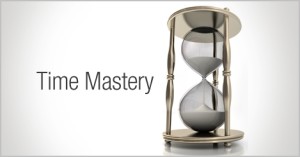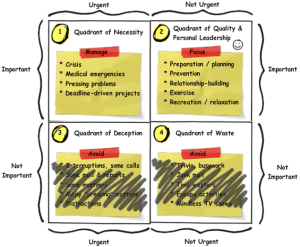Oct 27, 2014 | Planning & Goal Setting, Time Management

Would you rather lose time or money?
I often ask these questions in my workshops and get mixed answers. For many people the concept of losing money is understandably scary. There’s a simple reason for this. They have a mindset of scarcity rather than one of abundance.
In this mindset, losing money becomes a fear, but you must remember, you can always make more money, but you can never make more time. The reality is you can never get back time, once an hour, day, year is wasted, you can never get it back. You can leverage money, earn it back, replace it and grow to a point that you may not ever remember the loss, but time is finite. In life, you only get so many minutes.
The fear of losing money is a major factor in keeping many business owners from moving forward, but when you understand that time is your only finite asset; you can put this fear into a more useful perspective. A business owner is much more likely to take intelligent risks, and ultimately make better decisions, if they don’t have that fear. Questions like what if this idea doesn’t work, what if this is the wrong decision, what if, become much easier to answer when you know you can always make back what you invested into that decision. Yes, you must evaluate your decisions; you must test and measure everything that you do, but you must also be decisive, take risks and move on. The fear of losing money can keep you from being decisive. If you’re going to fail, it’s best to do it quickly and move on to the next idea.
But, you may ask, isn’t time equal to money?
It is, therefore you must invest it wisely. Are you relentlessly investing your time moving your business forward? Or are you poorly investing it to make yourself feel good, by checking off a bunch of “to do’s” that weren’t vital to your business’ success? Is your time focused on profitable activities, business growth, business opportunity, or are you in reactive mode?
Reactive mode usually wastes time, while proactive mode provides you the control and choice as to how and when you will invest your time. Gaining a clear understanding what is more important, time or money, can help you ultimately make better choices on how you spend your time.
Ask yourself the question for each task that you do: Is this activity moving me closer to increased revenue or profitability? If not, then either STOP IT, or delegate the task, and get back to doing something that will add to your bottom line.
And remember, time is irreplaceable – treasure it, invest it wisely and make sure you get a return on your investment. To learn more about investing your time wisely, join me for an upcoming TimeWise workshop.
Jul 29, 2014 | Planning & Goal Setting

What does it take to exit a business?
Being an entrepreneur is, to say the least, challenging. While being an entrepreneur gives us opportunities beyond our wildest dreams, those dreams can also become a nightmare.
Working with business owners, I find most of them have challenges with the day-to-day detail and operations of the business. The daily detail of dealing with cash flow, hiring, firing, marketing, selling and servicing customers is a consuming job, unless you know how to start running your company and stop having your company run you. If your company runs you, you will burn out, it’s just a matter of time. What happens next is you want OUT. You want out of the business and have no idea how to make that happen or where to start.
The truth is, we will all exit our business at some point. For some it is a well planned and executed event, for others it is a reaction to a set of circumstances that is either personal or economic. What really matters in each situation is the ability to have control over the end result.
You may have heard the phrase “Begin with the End in Mind.” The concept is to start and then run your business with the mental attitude that you will exit your business at some point, and know the result that you want in the end. Go back and read that sentence again, its critical to your success.
In this situation, your CPA, attorney, business brokers and business coach will all tell you that you need to prepare, plan and have your business perform as well without you as it does with you. This doesn’t happen overnight, or even in the first few years of running the business. But you still have to spend the time building an operation that has the right systems, a great team, financial checks and balances so you can get the desired value out of the business when you leave it.
Here are 2 examples: First, say you own a company that has the training and documented (yes that means in writing not in someone’s head) systems in place for all aspects of how the business operates. You track all critical Key Performance Indicators (leads, conversion rates, average dollar sales, revenue trends, profitability etc.) You have a team that knows what to do and how to do it, that carries what I call an above the line attitude (ownership, accountability and responsibility). The business is profitable month after month, quarter after quarter. The executive team knows the vision and mission of the organization and executes to it – even in your absence.
Now let’s look at another hypothetical company, one built around your strengths. Customers want to deal only with you. You are often turning over team members. The team doesn’t perform the way you want them to and is constantly blaming others. They have excuses and most deny that any issues are their fault. Cash flow is unpredictable and profitability is a word not often in your vocabulary.
Which business would you want to purchase? Which business will be easier to get a higher valuation and sell? What makes the difference between the two business owners and the results they receive?
After having run businesses, and now coaching business owners, for over 25 years, I’ve learned there are four key factors that make the difference.
1. Practice the concept that “Today Matters”. What do you do each day in building your business makes a difference in the long run. Each day do at least one thing that isn’t working IN your business, but “ON” your business. Have written specific goals that steer the business in the right direction. Read the book by John Maxwell – “Today Matters” for very practical tips
2. Learn the power of leverage. Document what you do, how you do it and train others. Hire differently than your competitors. Use a systematic recruiting process to hire on attitude first, skills second.
3. Know your Key Performance Indicators for financials, team, customers and overall business. KPI’s will help you see trends both good and bad and allow you to plan accordingly without reacting.
4. Have a team of outside advisers who hold you accountable to results. Whether you have run a business for 2 or 20 years you need someone from the outside challenging you to look at things differently and push you outside your comfort zone. Eleanor Roosevelt stated: “Do something every day that is outside your comfort zone.” That keeps making that zone larger and larger.
Jul 15, 2014 | Planning & Goal Setting, Self

Have you ever seen – or experienced – a business partnership ending badly?
I’ve seen it often. My experience is that out of every ten business partnerships, eight don’t work, one works very well, and one is just okay.
Often, the ones that don’t work have run into problems with each partner’s expectations of the business. In other words, the partners have key differences in their vision, in their targets and what they are trying to achieve in the business and in their risk tolerance. There is conflict in the partnership when one partner wants to go faster than the other, one partner wants to take it easy, or one partner has a higher appetite for risk than the other.
That can mean that a couple of years down the track, one partner is working a bit harder than the other and resentment is starting to build. Or, the business needs a cash injection and one partner has the money and the other doesn’t. One wants to invest time and money in going after a new contract or market share, while the other is happy with a steady, reliable business. That’s when problems start to show up.
The trouble is that there is so much emotion and excitement in starting a new business that the partners often just didn’t talk about these kinds of issues before they got started. A successful partnership needs – clear communication, a lot of what-if planning, and a written set of goals and overarching strategies.
- What if one of the partners wants to leave the business? How will you manage a buy out?
- What if you need a lot of capital suddenly? Whose personal assets will and will not be available?
- How do each of you define “success” in the business? Is there a particular milestone you each want to reach?
- How will you know when the business is “finished”? Do you intended to sell it? Run it forever and keep it in the family?
- How many hours a week are you really comfortable working? What about after the first few years of intense work are over?
- How much of a financial return are you each expecting? Now, and ultimately? If you each have different skills, do you value your time equally?
- How much personal or business debt can you each cope with, before you begin losing sleep over it?
These are the kinds of questions you need to discuss, and put down in writing, to form the basis of a successful partnership. When you’re working together, you need to know what to expect from one another. If you can see from this exercise that your expectations are not aligning on a lot of points, then you may need to consider other options rather than going into partnership.
To find out more about how to become aligned with your partner or team, get in touch with me.
Jun 24, 2014 | Planning & Goal Setting, Self, Time Management

Eat That Frog: Last week was the third installment in Time Management – “Time Mastery “. Now that you’ve had time to develop your vision, set and write down your goals and learned how to prioritize all of your tasks, you’re ready to take the final step – developing the habits to keep you focused for long-term success.
Okay. So, you’ve started your day, and there’s so much to do. Ever ask yourself, “Where do I start?” This is the first sign of a day of little accomplishment ahead. Many business owners I talk to have way too much on their plate: sales, marketing, finances, hiring, and let’s not forget actually providing your product or service. Many people, faced with so many balls to juggle, find it hard just to get started, so they choose to start with email. You think, “its easy, I can get through it quickly and then move on to more important things”. I know you’ve done it. You might even do it routinely.
So you dive into your inbox. And then the phone rings. And then an employee comes in asking for guidance. And then a customer calls. And before you know it, it is 5 p.m. and everyone is leaving the office except you, and you’re thinking “Jeez, I haven’t gotten anything done that I needed to get done today.”
There’s a way to stop the cycle, and it’s called “Eat That Frog!” If you’ve read this time management series this far, and you haven’t read this book by Brian Tracy, go order it NOW.
You must develop a new habit that can change everything when it comes to achieving your goals. The key to getting the results you want from yourself is to START each day by doing the number one goal you have for the day. The best time to identify that task? The night before. Every day, the last thing you do at the end of your workday is WRITE DOWN your top 2-3 priorities for the next day. Then when morning comes, you’re ready to “Eat That Frog!”
What the heck? You might be asking about now. Mark Twain once said, if your list of things to do today includes eating a frog, do that first, and know nothing worse is going to happen the rest of the day. Your “frog” is the most important, and biggest task on your list – the one you are most likely to procrastinate about doing. Skip the inbox, skip the interruptions, get right down to eating that frog. Block out the time on your calendar, and stick to it.
Continually ask yourself “Which one project or activity, if I did it in an excellent and timely fashion, would have the greatest positive impact on my life?” And conversely, which one, “if I DON’T get it done, will have the most negative impact?” Then develop the habit of asking yourself throughout the day, “is this the best use of my time right now”. Did you eat your frog?
It takes 21 days on average to develop a new habit, after that you won’t have to think about it, you’ll just be doing it. Start today. Write out your frog for tomorrow. Then do it!
Get in touch with me to find out when my next time management workshop will be held.
Jun 17, 2014 | Planning & Goal Setting, Self, Time Management

Time Mastery – How To Get The Best of You
Time Mastery – Last week was the second installment in Time Management – “Setting Your Goals”. Now that you’ve had time to think about your vision, work out your ideal future state, and set and write down your specific SMART goals, you’re ready to take the next step – how to work on the RIGHT things to accelerate achievement of your goals.
Time Mastery is one of the most difficult and most critical challenges facing business owners today – how to efficiently utilize your most valuable resource – your TIME! The things that you choose to spend your time on in your business will have a significant influence on how successful you are as a business owner.
Stephen Covey in his “7 Habits” and “First Things First” books describes a simple matrix of Importance vs. Urgency to easily categorize how you allocate your time investment to have the most positive impact on achieving your goals. These four areas can also be called Waste, Deception, Necessity and lastly Quality & Leadership or Strategic.

You’ll find things like e-mail and surfing the web are most often Not Urgent and Not Important – or Waste. It is critical to avoid spending much time on these activities during the day. Many phone calls and walk in requests fall into the category of Urgent and Not Important. They come to you because someone else did not do what they were supposed to or because there is no process in place to handle the situation. Many customer calls or production issues are Urgent and Important. You handle them to satisfy a customer or keep the operation moving, but they suck time from you largely because there was no system in place to handle the issue properly in the first place. Does any of this sound familiar to you?
It might surprise you to know that the quadrant where you want to spend the most time is the Important and Not Urgent corner. This is where you find focus, and work on things like strategy, planning, goal setting and relationship building. The biggest challenge for you as business owner is to spend as much time as possible in this corner. These are the Strategic decisions that will determine where you take your business and if you accomplish your goals. Because the projects in this corner are not Urgent, they often times get pushed back in the priority stack – and then just get forgotten or just never done. As the business owner, it is your job to invest your TIME on these areas of your business. If you do not, who will?
So you ask, how do I make time to focus on the Not Urgent but Important? One practical idea is to bake it into your schedule. I call it using a Default Calendar. That is blocking the time on your calendar for those critical tasks you must do even though there is not an emergency driving them. When you put the BIG, CRITICAL items into your calendar first, you will always find time to fit in the other, smaller items.
And, related to this thought, when you put the big items into your calendar, FOCUS ON THEM! Resist the urge to blow right past them and put them off. Discipline yourself to focus first on the Strategic and them the operational and execution-oriented activities will flow more naturally.
Try it! If you have a white board in your office, draw the matrix there, and list your projects and activities in each quadrant. Make sure you are spending blocks of quality time in the Important & Not Urgent corner. How you spend your time will determine your ultimate level of success.
Need help with setting goals and planning? Our next GrowthClub 90 Day Planning & Strategy workshop is coming up on Sep 23rd. Its your chance spend a day in quadrant 2!
Jun 9, 2014 | Planning & Goal Setting, Self

Setting Your Goals. Last week was the first installment in Time Management – “Destination: Where are you going?” Now that you’ve had time to think about your vision and work out what your ideal state (for your life, business, career, etc.) looks like in 1, 5 or 10 years, you’re ready to take the next step and define the specific goals that will get you there.
Do you have written goals for your business? One year out, three years out? What about the next 90 days? If you don’t know very explicitly and clearly what your goals are, which determines your priorities, then how can you possibly know what is the best use of your hours TODAY? And how can you know if those goals will get you to your vision?
Many business owners operate without a real clear picture of the goals they have for their business. They seem to just go through the paces, week after week, without knowing whether they are ahead or behind on meeting their goals. I think the reason most business owners do this is because if they never commit to specific goals, then they can’t fail when they miss them. It keeps them from failing; it also keeps them from succeeding.
Goal setting, and using those goals to drive your daily priorities is a habit you can develop. Like any learned habit, typically will take at least 21 days to develop, and then many months and years to refine until you master the discipline.
There is a lot of material and advice out there about goal setting, but here is a simple and effective process for setting goals :
1. Decide exactly what you want. Be clear, specific and write it down on paper. The very act of writing down a goal significantly increases the likelihood that you will achieve it.
2. Make your goals measurable. Your goals should have clear metrics for their achievement. For example, a goal to “become the best salesperson” is a nice goal, but how do you measure “best”? To make this goal measurable, it could be restated in the following way, “I will achieve $1,000,000 in gross sales revenue, helping me reach the top sales position in the company.”
3. Make a list. Write down everything you must do to achieve each goal, including every step, actions, strategies, decisions, milestones, etc.
4. Set a deadline for each of your goals. This will help you overcome the human tendency to procrastinate and will exert some pressure for you to stay on task.
5. Finally, develop an action plan from the list of activities and immediately take action on your plan. Resolve to do something every day to get you closer to your goals.
Clearly written goals will have a powerful effect on your thinking and will motivate you into action. They act as the “guiding lights” to keep you on task, using your time in the most effective manner possible, keeping you focused on your priorities. Make a habit of asking yourself throughout the day if what you are doing right now is moving you towards your goals. If not, STOP what you’re doing and do something that will.
Need help with setting goals and planning? Our GrowthClub 90 Day Planning workshop is coming up on June 16th. It’s your chance to take a day out of your business to work ON your business!







